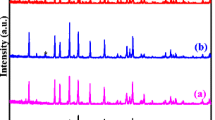Abstract
Garnet-type Li6.4La3Zr1.4Ta0.6O12 (LLZTO) is considered as one of the most potential electrolytes for solid state lithium batteries. Sintering process is a critical step in the preparation of LLZTO. Herein, LLZTO solid-state electrolytes were prepared by high temperature solid-phase reaction with different sintering temperature from 1150 to 1250 °C and different sintering holding time from 1 min to 60 min. According to EIS, electrolytes with high ionic conductivity up to 8.1 × 10−4 S cm−1 were obtained by sintering at 1200 °C for 20 min. Besides, LLZTO pellets prepared in this experimental condition show high density reaching up to 97.6%. Li symmetric cell with the LLZTO sintered at 1200 °C for 20 min also exhibits stable cycle performance under current density of 0.25 mA cm−2 at room temperature.
Access this chapter
Tax calculation will be finalised at checkout
Purchases are for personal use only
Similar content being viewed by others
References
Doughty, D.H., P.C. Butler, A. Akhil, et al. 2010. Batteries for large-scale stationary electrical energy storage. Electrochemical Society Interface 19: 49–53.
Samson, A.J., K. Hofstetter, S. Bag, et al. 2019. A bird’s-eye view of Li-stuffed garnet-type Li7La3Zr2O12 ceramic electrolytes for advanced all-solid-state Li batteries. Energy & Environmental Science 12 (10): 2957–2975.
Liu, Q., Z. Geng, C. Han, et al. 2018. Challenges and perspectives of garnet solid electrolytes for all solid-state lithium batteries. Journal of Power Sources 389: 120–134.
Zhang, B., R. Tan, L. Yang, et al. 2018. Mechanisms and properties of ion-transport in inorganic solid electrolytes. Energy Storage Materials 10: 139–159.
Ferraresi, G., M. El Kazzi, L. Czornomaz, et al. 2018. Electrochemical performance of all-solid-state li-ion batteries based on garnet electrolyte using silicon as a model electrode. ACS Energy Letters 3 (4): 1006–1012.
Han, F., J. Yue, C. Chen, et al. 2018. Interphase engineering enabled all-ceramic lithium battery. Joule 2 (3): 497–508.
Bachman, J.C., S. Muy, A. Grimaud, et al. 2016. Inorganic solid-state electrolytes for lithium batteries: mechanisms and properties governing ion conduction. Chemical Reviews 116 (1): 140–162.
Manthiram, A., X. Yu, and S. Wang. 2017. Lithium battery chemistries enabled by solid-state electrolytes. Nature Reviews Materials 2 (4): 16103.
Takada, K. 2018. Progress in solid electrolytes toward realizing solid-state lithium batteries. Journal of Power Sources 394: 74–85.
Shoji, M., E.J. Cheng, T. Kimura, et al. 2019. Recent progress for all solid state battery using sulfide and oxide solid electrolytes. Journal of Physics. D. Applied Physics 52 (10): 103001.
Kato, Y., S. Hori, T. Saito, et al. 2016. High-power all-solid-state batteries using sulfide superionic conductors. Nature Energy 1 (4): 16030.
Shen, F., W. Guo, D. Zeng, et al. 2020. A simple and highly efficient method toward high-density garnet-type LLZTO solid-state electrolyte. ACS Applied Materials and Interfaces.
Xue, W., Y. Yang, Q. Yang, et al. 2018. The effect of sintering process on lithium ionic conductivity of Li6.4Al0.2La3Zr2O12 garnet produced by solid-state synthesis. RSC Advances 8 (24): 13083–13088.
Gong, Y., Z.-G. Liu, Y.-J. Jin, et al. 2019. Effect of sintering process on the microstructure and ionic conductivity of Li7–xLa3Zr2–xTaxO12 ceramics. Ceramics International 45 (15): 18439–18444.
Huang, M., A. Dumon, Y. Shen, et al. 2013. Effect of Lithium content and sintering time on conductivity of Li7La3Zr2O12 as solid electrolyte. Journal of the Chinese Ceramic Society 41.
Author information
Authors and Affiliations
Corresponding author
Editor information
Editors and Affiliations
Rights and permissions
Copyright information
© 2021 Beijing Oriental Sun Cult. Comm. CO Ltd
About this paper
Cite this paper
Gao, J., Guo, W., Yang, H., Shen, F., Han, X. (2021). Effect of Sintering Temperature and Holding Time on Ionic Conductivity for Li6.4La3Zr1.4Ta0.6O12 Electrolyte. In: Chen, W., Yang, Q., Wang, L., Liu, D., Han, X., Meng, G. (eds) The Proceedings of the 9th Frontier Academic Forum of Electrical Engineering. Lecture Notes in Electrical Engineering, vol 743. Springer, Singapore. https://doi.org/10.1007/978-981-33-6609-1_38
Download citation
DOI: https://doi.org/10.1007/978-981-33-6609-1_38
Published:
Publisher Name: Springer, Singapore
Print ISBN: 978-981-33-6608-4
Online ISBN: 978-981-33-6609-1
eBook Packages: EnergyEnergy (R0)




